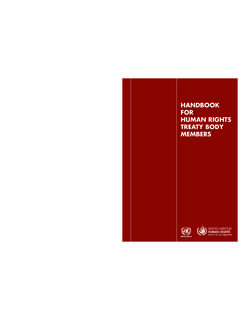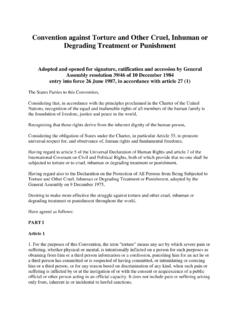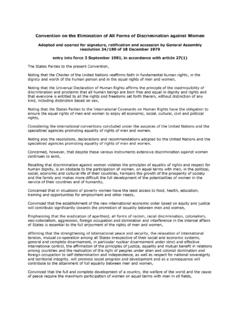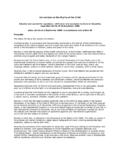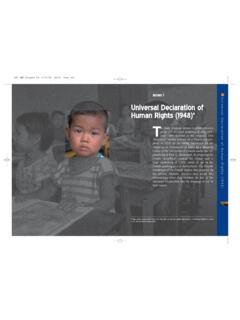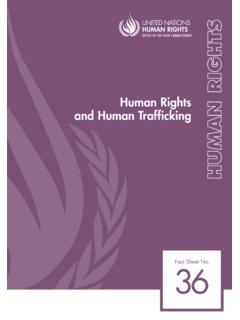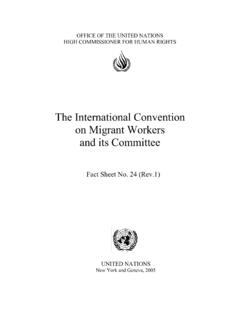Transcription of Handbook Parliamentarians - Human Rights
1 Human Rights Handbook for Parliamentarians N 26 Pantone: 320 CC: 90 M: 0 Y: 30 K: 0R: 0 G: 170 B: 190 Pantone: 3015 CC: 100 M: 45 Y: 5 K: 20R: 0 G: 95 B: 154 Pantone: Cool Gray 9 CC: 3 M: 0 Y: 0 K: 65R: 121 G: 122 B: 123 Cover PageThe principle of universality of Human Rights is the cornerstone of international Human Rights law. International Human Rights law lays down obligations of governments to act in certain ways or to refrain from certain acts in order to promote and protect Human Rights and fundamental freedoms of all individuals or groups.
2 Anadolu Agency/Serap Aydin inter -Parliamentary Union 2016 This publication is co-published by the inter -Parliamentary Union and the United Nations (Office of the High Commissioner for Human Rights ).For personal and non-commercial use, all or parts of this publication may be reproduced on condition that copyright and source indications are also copied and no modifications are made. Please inform the inter -Parliamentary Union on the usage of the publication : Simplecom graphicsPrinted by Courand et Associ sISBN 978-92-9142-657-7 (IPU) HR/PUB/16/4 (UN)1 ContentsAcknowledgements 7 Foreword 8 Abbreviations 9 Boxes 13 Chapter 1 What are Human Rights ?
3 19 Definition 19 Basic Human Rights principles 21 Human Rights and State sovereignty 27 The Responsibility to Protect 27 Democracy, Human Rights and parliaments 29 Chapter 2 Which State obligations arise from Human Rights ? 31 What does the obligation to respect mean? 32 What does the obligation to protect mean? 32 What does the obligation to fulfil mean? 33 The principle of progressive realization 34 The right to an effective remedy 35 The right to recourse to an international or regional Human Rights mechanism 36 The right to reparation for harm suffered 37 Remedies for violations of economic.
4 Social and cultural Rights 38 Chapter 3 International Human Rights instruments 41 The emergence of international Human Rights law 41 The International Bill of Human Rights 42 Core international Human Rights treaties 43 Other Human Rights instruments of the United Nations 442 Chapter 4 May states restrict Human Rights ? 47 Limitation clauses 48 Derogation during a state of emergency 48 Reservations 51 Chapter 5 United Nations Human Rights treaty monitoring bodies 53 Membership and functioning 54 Reporting procedure 54 Obligations of states 54 Examination of State reports 55 The role of NGOs.
5 Parliaments and other organizations in the treaty-body procedure 55 General comments issued by treaty-monitoring bodies 56 Individual complaints procedure 57 inter -State complaints procedure 59 Inquiry procedures 59 The system of regular visits to detention centres established under the Optional Protocol to CAT 61 Follow-up to recommendations 61 Chapter 6 Charter-based system of Human Rights : the United Nations Human Rights Council and its mechanisms 65 From the Commission on Human Rights to the Human Rights Council 66 The Commission on Human Rights 66 The Human Rights Council 67 The Universal Periodic Review 68 Special procedures 69 Human Rights Council complaint procedure 703 Chapter 7 The Office of the United Nations High Commissioner for Human Rights 73 History 73 How OHCHR works 74 OHCHR in the field 76 Chapter 8 Regional Human Rights treaties and monitoring 79 Africa 79 The Americas 81 Arab region 82 Asia and the
6 Pacific 83 Europe 84 Council of Europe 84 European Union 85 Organization for Security and Cooperation in Europe 86 Chapter 9 Basic requirements for an effective parliamentary contribution to Human Rights 89 Basic principles 89 Ensuring the representative nature of parliament 90 Protecting the freedom of expression of Parliamentarians 91 Understanding the legal framework, in particular parliamentary procedure 94 Determining parliament s role in states of emergency 94 Chapter 10 Parliamentary functions to promote and protect Human Rights 95 Ratifying Human Rights treaties 954 Ensuring national implementation 97 Adopting enabling legislation 97 Approving the budget 100 Overseeing the executive branch 101 Following up on recommendations and decisions 101 Getting involved with the Universal Periodic Review 103 Mobilizing public opinion 105 Participating in international efforts 106 Chapter 11 Parliamentary
7 Institutional structure and relations with other national stakeholders 111 Establishing parliamentary Human Rights bodies 111 Creating and supporting an institutional infrastructure 112 National Human Rights institutions 112 Ombudsperson s office 116 National Human Rights action plans 116 Relationship between parliaments and civil society 117 Chapter 12 What Parliamentarians should know about civil and political Rights 119 The right to life 119 Prohibition of torture and cruel, inhuman or degrading treatment or punishment: the right to personal integrity and dignity 129 The right to personal liberty and security 135 Administration of justice.
8 The right to a fair trial 138 The right to privacy and the protection of family life 145 Freedom of movement 151 Freedom of thought, conscience and religion 154 Freedom of opinion and expression 157 Freedom of peaceful assembly and association 165 The right to participate in public affairs 1685 Chapter 13 What Parliamentarians should know about economic, social and cultural Rights and the right to development 173 Globalization, development and economic, social and cultural Rights 174 The right to development 182 What is the right to development?
9 182 The right to development in the context of the 2030 Agenda, the Sustainable Development Goals and related processes 183 The right to social security 184 The right to work and Rights at work 187 The right to an adequate standard of living 191 The right to education 208 Cultural Rights 213 Chapter 14 Human Rights , terrorism and counter-terrorism 217Is terrorism a violation of Human Rights ? 218 The notion and definition of terrorism 219 states of emergency and the normal operation of counter-terrorism law and practice 220 Chapter 15 Combating impunity: the international criminal court 223Ad hoc international criminal tribunals: the International Criminal Tribunal for the former Yugoslavia (ICTY); the International Criminal Tribunal for Rwanda (ICTR).
10 And internationalized (hybrid) tribunals 224 The International Criminal Court 225 Set of principles for the protection and promotion of Human Rights through action to combat impunity 230 Annex: The core international Human Rights instruments 23367 AcknowledgementsThis updated version of the Handbook , originally published in 2005, was jointly prepared by the Office of the United Nations High Commissioner for Human Rights (OHCHR) and the inter -Parliamentary Union (IPU).Principal contributor to the 2005 edition: Manfred Nowak, Professor of International Human Rights at the University of Vienna and Secretary General of the European inter -University Centre for Human Rights and IPU-OHCHR editorial task force: Rogier Huizenga and Roberto Rodriguez Valencia (IPU), and staff of the Rule of Law and Democracy Section (OHCHR).


